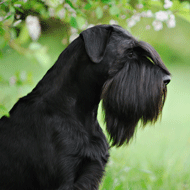Blinding inherited condition found in giant schnauzers

The genetic mutation that causes PRA in giant schnauzers occurs in approximately one in 35 dogs.
Scientists at the Animal Health Trust (AHT) have developed a DNA test for progressive retinal atrophy (PRA) in giant schnauzers, a previously undiagnosed condition in the breed.
PRA may initially cause dogs to lose their vision in low light at night, have difficulty seeing obstacles or finding their way in familiar surroundings. Visual impairment worsens over months or years and, eventually, all affected dogs will lose their sight.
The condition is well documented in more than 100 dog breeds but had not previously been identified in giant schnauzers.
DNA samples were sent to AHT from a litter of four-year-old giant schnauzers, two of which had previously been diagnosed with PRA. Testing confirmed one further dog from the same litter also had PRA, while the parents were clear of the disease.
This confirmed the presence of an autosomal recessive PRA, where the affected dog has to carry two copies of the PRA-causing variant to develop the disease.
Scientists were able to identify the causal mutation - a single letter change in the 2.4 billion letter DNA code. They discovered this mutation occurs in approximately one in 35 giant schnauzers.
Research assistant Rebekkah Hitti said: “As this condition in the Giant Schnauzer is quite rare we’re not expecting to find many affected dogs through DNA testing, but it is crucial to identify any carriers in order to prevent more puppies being born with this blinding condition, and to stop it becoming more widespread in future.
“We’ve had a good level of interest in this research so far from Schnauzer breeders and we’re confident that this breeding community is keen to get this mutation under control, and in time, eradicate it safely from their breed altogether.”
The DNA test costs £48 and is now available from the AHT DNA Testing Service.



 The BSAVA has opened submissions for the BSAVA Clinical Research Abstracts 2026.
The BSAVA has opened submissions for the BSAVA Clinical Research Abstracts 2026.